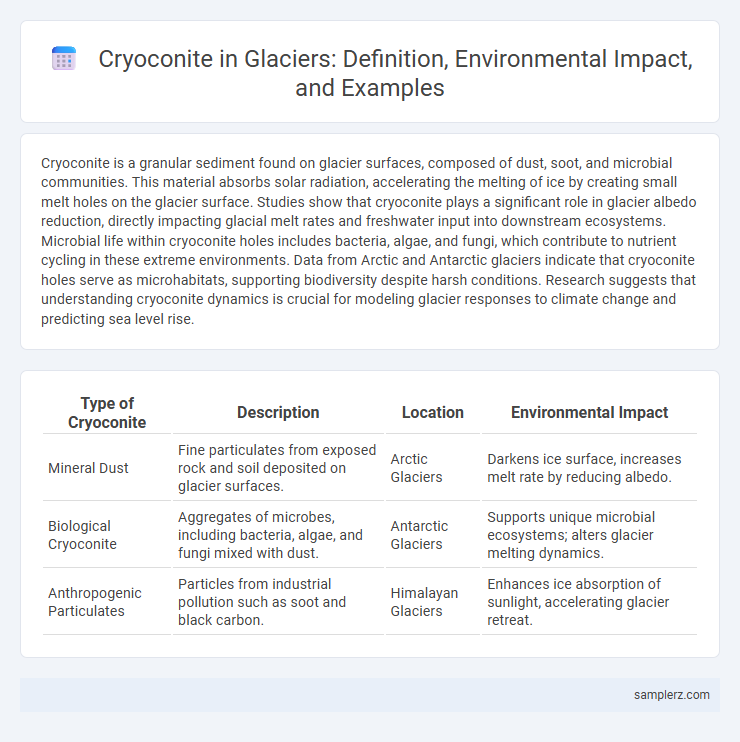Cryoconite is a granular sediment found on glacier surfaces, composed of dust, soot, and microbial communities. This material absorbs solar radiation, accelerating the melting of ice by creating small melt holes on the glacier surface. Studies show that cryoconite plays a significant role in glacier albedo reduction, directly impacting glacial melt rates and freshwater input into downstream ecosystems. Microbial life within cryoconite holes includes bacteria, algae, and fungi, which contribute to nutrient cycling in these extreme environments. Data from Arctic and Antarctic glaciers indicate that cryoconite holes serve as microhabitats, supporting biodiversity despite harsh conditions. Research suggests that understanding cryoconite dynamics is crucial for modeling glacier responses to climate change and predicting sea level rise.
Table of Comparison
| Type of Cryoconite | Description | Location | Environmental Impact |
|---|---|---|---|
| Mineral Dust | Fine particulates from exposed rock and soil deposited on glacier surfaces. | Arctic Glaciers | Darkens ice surface, increases melt rate by reducing albedo. |
| Biological Cryoconite | Aggregates of microbes, including bacteria, algae, and fungi mixed with dust. | Antarctic Glaciers | Supports unique microbial ecosystems; alters glacier melting dynamics. |
| Anthropogenic Particulates | Particles from industrial pollution such as soot and black carbon. | Himalayan Glaciers | Enhances ice absorption of sunlight, accelerating glacier retreat. |
Introduction to Cryoconite: Definition and Formation
Cryoconite consists of dark, granular sediment found on glacier surfaces, formed through a mixture of dust, soot, and microbial activity. These particles absorb solar radiation, accelerating ice melt and creating cryoconite holes that act as microhabitats for bacteria and algae. Understanding cryoconite formation provides insight into glacier surface processes and their impact on climate feedback mechanisms.
The Role of Cryoconite in Glacier Melt
Cryoconite, a dark granular sediment found on glacier surfaces, plays a critical role in accelerating glacier melt by decreasing the albedo and increasing heat absorption. Composed of dust, soot, and microbial communities, cryoconite traps solar radiation, which enhances localized melting and influences glacier hydrology. The presence of cryoconite holes creates microhabitats that further affect ice melting rates and nutrient cycling within glacial ecosystems.
Composition and Structure of Cryoconite Granules
Cryoconite granules on glaciers primarily consist of a mixture of mineral particles, organic matter, and microbial communities, including cyanobacteria, algae, and heterotrophic bacteria. These granules exhibit a porous structure that promotes the retention of water and nutrients, facilitating microbial metabolism and growth under extreme cold conditions. Their complex composition and structure significantly influence glacier surface albedo and melt dynamics through heat absorption and localized ice melting.
Microbial Communities in Cryoconite Holes
Microbial communities in cryoconite holes on glaciers are diverse ecosystems dominated by bacteria, cyanobacteria, and microalgae that contribute significantly to biogeochemical cycles. These microorganisms drive nutrient cycling by fixing carbon and nitrogen, influencing melt rates through darkening the ice surface and altering albedo. Studies reveal intricate microbial interactions that sustain these microhabitats, making cryoconite holes hotspots for microbial diversity and environmental change indicators in glacial ecosystems.
Geographic Distribution of Cryoconite on Global Glaciers
Cryoconite deposits are primarily found on glaciers across the Arctic, Antarctic, and high-altitude mountain ranges such as the Himalayas, Alps, and Andes. These granular sediments accumulate in cryoconite holes where microbial communities thrive, influencing glacier surface albedo and melt rates. Distribution patterns of cryoconite vary with regional climate, glacier type, and atmospheric dust inputs, playing a critical role in global cryospheric processes.
Observed Examples of Cryoconite in the Arctic and Antarctic
Cryoconite, a granular sediment composed of dust, soot, and microbial communities, is prominently observed on glaciers in both the Arctic and Antarctic regions, significantly affecting ice albedo and melting rates. Arctic glaciers, such as those in Svalbard and Greenland, show extensive cryoconite holes inhabited by cyanobacteria and algae, which create dark patches accelerating surface ice melt. Antarctic glaciers, including locations in the McMurdo Dry Valleys and the Antarctic Peninsula, reveal cryoconite deposits that host diverse microbial ecosystems influencing local biogeochemical cycles and cryosphere dynamics.
Impacts of Cryoconite on Glacier Albedo Reduction
Cryoconite, a dark granular sediment composed of dust, soot, and microbial matter, significantly reduces glacier albedo by darkening the ice surface and increasing solar absorption. This lower albedo accelerates melting rates and contributes to glacier mass loss, impacting freshwater availability and sea-level rise. Studies in Arctic and Antarctic glaciers reveal that cryoconite presence can decrease albedo by up to 20%, intensifying the effects of climate warming on polar ice sheets.
Climate Change Effects on Cryoconite Accumulation
Climate change accelerates glacier melting, increasing meltwater flow that transports and concentrates cryoconite on glacier surfaces. Enhanced cryoconite accumulation darkens ice, reducing albedo and further intensifying localized melting. This positive feedback loop amplifies glacier retreat and alters microhabitats within cryoconite holes, impacting microbial ecosystems.
Human Influence on Cryoconite Formation and Spread
Human activities such as industrial pollution and mining release particulate matter that deposits on glacier surfaces, accelerating the formation and darkening of cryoconite. This anthropogenic input enhances microbial growth within cryoconite holes, increasing the melting rate of glaciers. The spread of cryoconite is further influenced by human-induced climate change, which alters precipitation patterns and glacier dynamics.
Cryoconite as an Indicator for Glacier Health and Environmental Change
Cryoconite, a mixture of dust, soot, and microorganisms found on glacier surfaces, acts as a crucial indicator for glacier health and environmental change by influencing albedo and melting rates. Variations in cryoconite composition and distribution reveal shifts in atmospheric pollution levels and microbial ecosystem dynamics linked to climate change. Monitoring cryoconite patterns provides valuable data for assessing glacier mass balance and predicting future glacial retreat in response to global warming.

example of cryoconite in glacier Infographic
 samplerz.com
samplerz.com